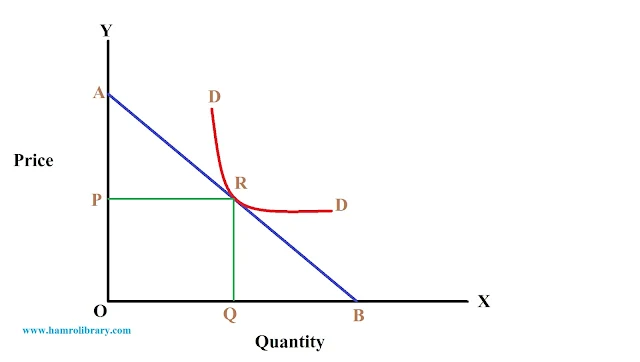Measurement of Price elasticity of Demand:
In order to measure the price elasticity of demand, we have the following major methods:
B. Point method (Geometric Method) of measuring Price elasticity of Demand
ii. Point elasticity on a non-linear demand curve:
Point elasticity on a non-linear demand cure is measured by drawing a tangent to the demand curve at the chosen point and measuring the elasticity of the tangent at this point. This gives the elasticity of the demand curve at the chosen point.
Suppose, we want to measure the price elasticity of demand curve DD at point R in the figure. Let us draw a tangent line AB at point R of demand curve DD as shown in the above figure. Since, demand curve DD and the tangent line AB passes through the same point (R), the price elasticity of demand curve DD at point R is equal to the elasticity to the tangent line AB at point R.
By measuring the price elasticity at point R on the tangent line AB, we get the elasticity at point R on the demand curve DD. The elasticity of the tangent AB at point R is given by :
By measuring the price elasticity at point R on the tangent line AB, we get the elasticity at point R on the demand curve DD. The elasticity of the tangent AB at point R is given by :
Ep = (Lower segment of the demand curve)/ Upper Segment of the demand curve
Ep = RB/AR
C. Percentage Method of measuring Price elasticity of Demand
The percentage method of measuring price elasticity of demand was developed by Prof. Flux as an improvement over the total outlay method. The percentage method measures price elasticity by using the coefficient. The coefficient (Ep) measures the percentage change in the quantity demanded of a commodity resulting from a given percentage change in its price. C. Percentage Method of measuring Price elasticity of Demand
The following formula is used to calculate the elasticity of demand using the percentage method:
Ep = Percentage Change in Quantity Demanded / Percentage Change in Price

Where,
∆P=Change in price
∆Q=Change in quantity demanded
p=Initial price
q=Initial quantity
D. Arc Elasticity of Demand
The coefficient of price elasticity of demand between two points on a demand curve is called arc elasticity of demand. This method is used when there is a large change in price and quantity demanded. Any two points on a demand curve make an arc as shown in the figure below:
Ep = Percentage Change in Quantity Demanded / Percentage Change in Price

Where,
∆P=Change in price
∆Q=Change in quantity demanded
p=Initial price
q=Initial quantity
D. Arc Elasticity of Demand
The coefficient of price elasticity of demand between two points on a demand curve is called arc elasticity of demand. This method is used when there is a large change in price and quantity demanded. Any two points on a demand curve make an arc as shown in the figure below:
The area between A and B on the DD demand curve is an arc, which measures elasticity over a certain range of price & quantities. The point method of measuring elasticity at two points on a demand curve gives different elasticity coefficients because we used a different base in computing the percentage change in each case.
To avoid this discrepancy, elasticity for the arc is calculated by taking the average of the two prices: (P1 + P2)/2 and the average of the two quantities (Q1+Q2)/2.
The formula for measuring price elasticity of demand at the middle point C of the arc on the demand curve is:
To avoid this discrepancy, elasticity for the arc is calculated by taking the average of the two prices: (P1 + P2)/2 and the average of the two quantities (Q1+Q2)/2.
The formula for measuring price elasticity of demand at the middle point C of the arc on the demand curve is:
Where,
Q1 = Initial Quantity Demanded
Q2 = New Quantity Demanded
P1 = Initial Price
P2 = New Price
ΔQ = Change in Quantity Demanded
ΔP = Change in Price




.jpeg)
0 Comments
If this article has helped you, please leave a comment.